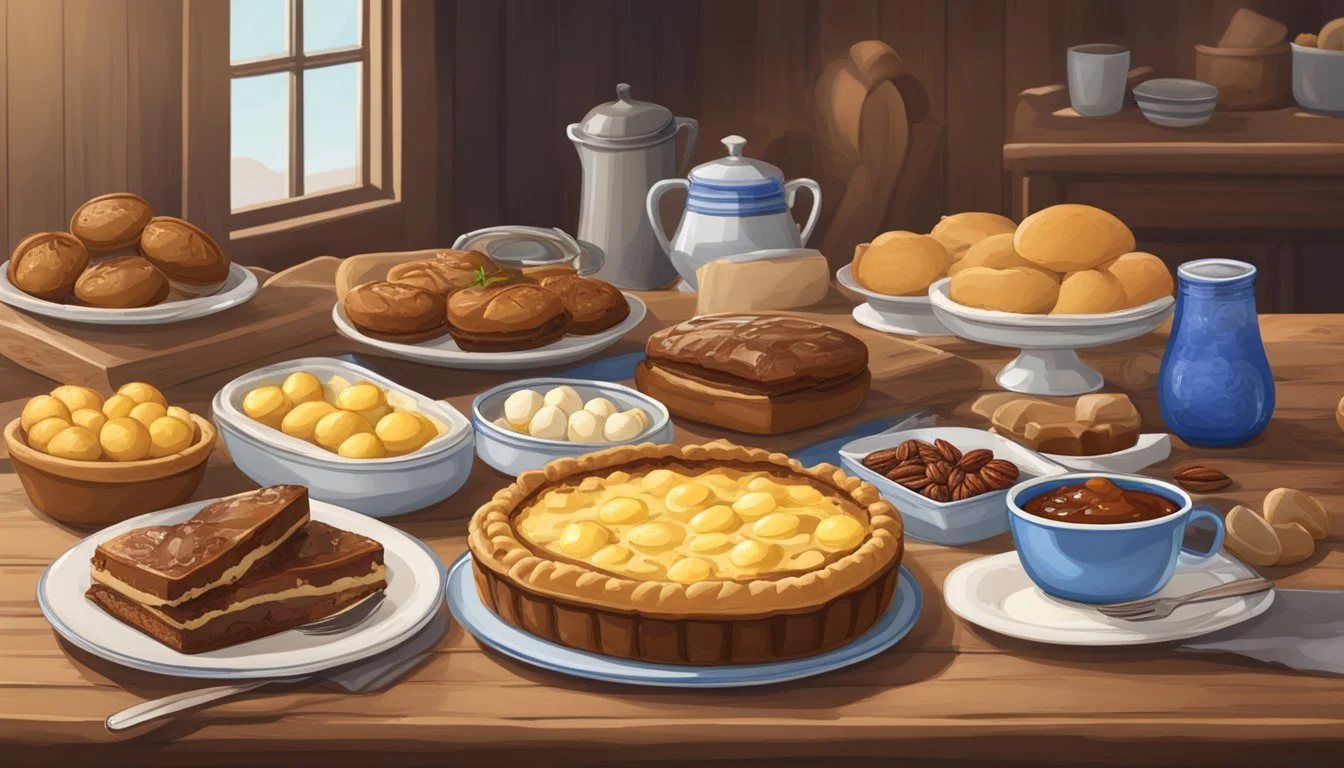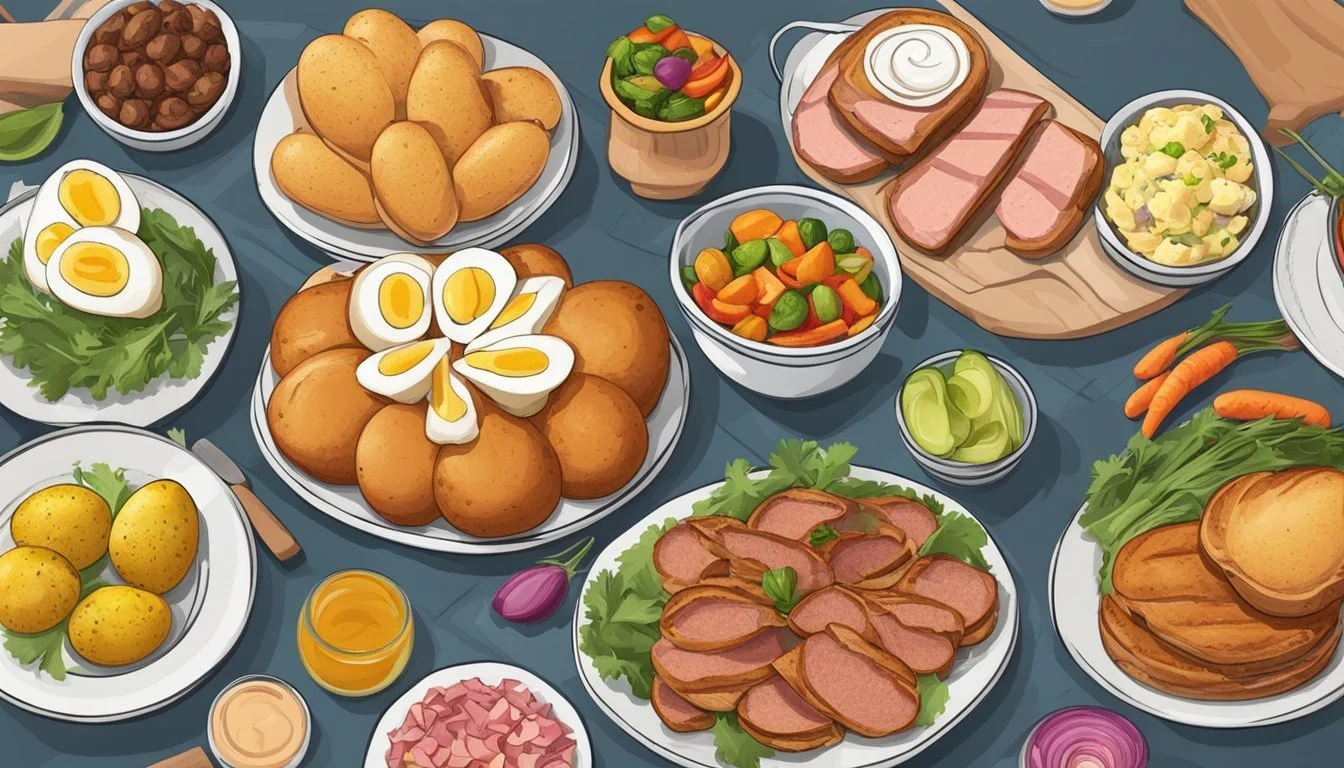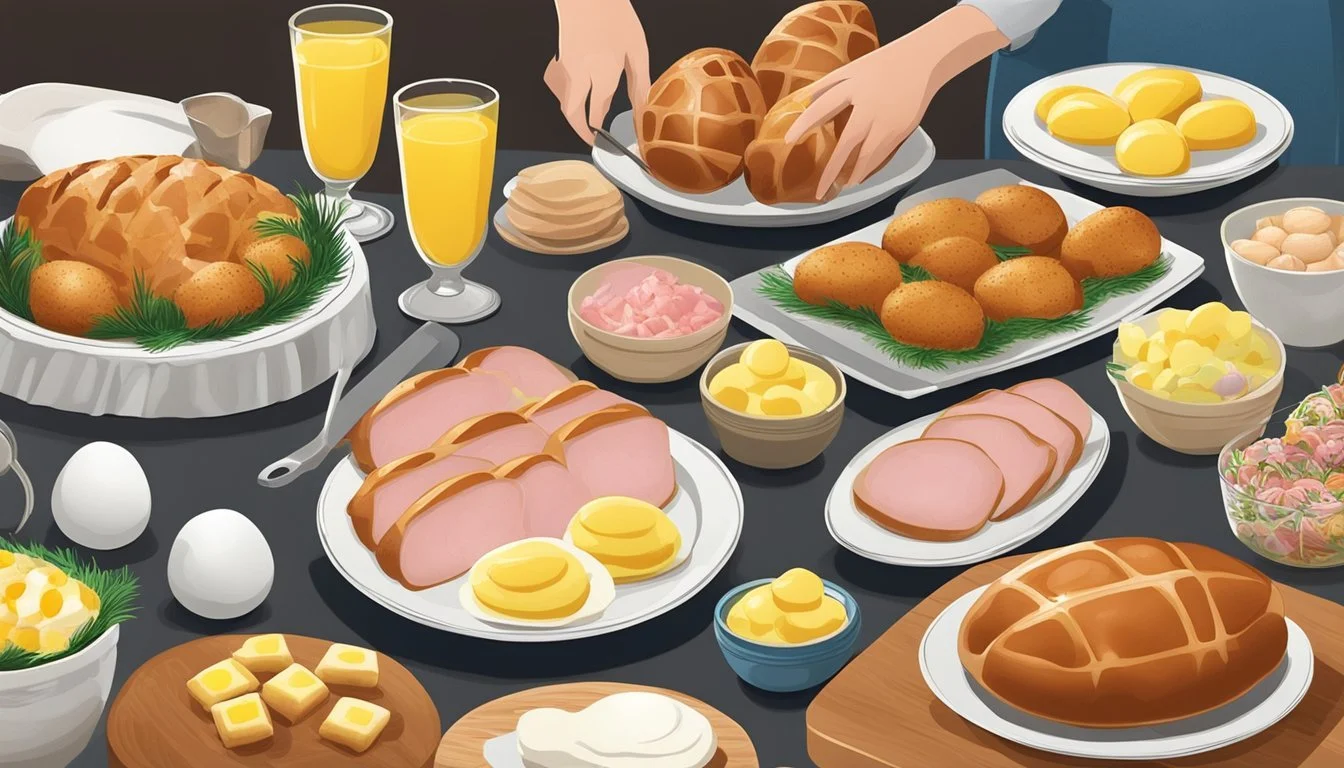5 Texas Food Traditions for Easter
Celebrating with Flavor and Heritage
Easter in Texas is a time when families come together to celebrate with a mix of time-honored traditions and unique regional flavors. Texas offers a rich tapestry of culinary delights that reflect its diverse cultural heritage, making the holiday both a feast for the stomach and the soul.
Readers can expect to explore five distinct Texas food traditions that add a special touch to their Easter celebrations. From savory main dishes to sweet treats, these traditions are sure to enhance any gathering with unmistakable Texan charm.
1) Cascarones (Confetti Eggs)
Cascarones, or confetti-filled eggs, are a vibrant Mexican tradition cherished in Texas. These colorful eggs are typically prepared during Holy Week. Families crack a small hole at the top, drain the yolk and white, and then dye the shells in vivid colors. They fill the dried shells with confetti.
Once filled and sealed with tissue paper, cascarones are ready for fun. Children and adults alike enjoy smashing them over each other's heads. It's a playful tradition, especially popular during Easter gatherings.
The tradition of cascarones extends to other festive occasions. Events like Fiesta in San Antonio see widespread use of these confetti eggs. During such events, the streets come alive with people cracking cascarones over friends and strangers, adding an extra burst of color and joy to celebrations.
Making cascarones at home can also be a delightful family activity. Materials needed include eggs, dye, confetti, and tissue paper. The process of creating and filling each egg provides a fun, hands-on project that involves everyone, from children to grandparents.
Through generations, the tradition of cascarones continues to bring communities together. It’s a testament to how cultural practices evolve and are kept alive by both young and old alike. Cascarones embody the spirit of festivity and communal fun, making them a beloved part of Texas Easter celebrations.
2) Hot Cross Buns
Hot Cross Buns are a beloved Easter tradition in Texas, celebrated for their rich flavors and historical significance. These spiced, sweet buns are typically made with a lightly-sweetened yeast dough. They often include raisins or currants, and are spiced with cinnamon and nutmeg.
The buns are marked with a cross on top, symbolizing the crucifixion of Jesus Christ, making them especially meaningful during the Easter season.
Hot Cross Buns are believed to date back to the 12th century when an English monk first baked them on Good Friday. This tradition has carried through the centuries and has found its place in many Easter celebrations, including those in Texas.
Bakers in Texas often follow traditional recipes but add their own twist to suit local tastes. Some variations include using different types of dried fruits like cranberries or apricots, and adding extra spices for a unique flavor.
These buns are typically enjoyed warm, sometimes with a simple glaze or icing. They make for a delightful breakfast or dessert during the Easter festivities.
Many Texas bakeries offer Hot Cross Buns in the weeks leading up to Easter, ensuring that this time-honored treat remains accessible to those looking to celebrate the holiday with a touch of tradition.
3) Barbacoa Tacos
Barbacoa tacos exemplify a cherished Easter tradition in Texas, blending rich flavors with cultural heritage. This dish features meat, often beef or lamb, slow-cooked until tender. The process infuses the meat with a distinct, savory taste.
Historically rooted in pre-Hispanic traditions, barbacoa has evolved while staying true to its origins. Prepared mainly during weekends, it serves as a communal meal bringing families together.
In Texas, barbacoa tacos frequently feature beef cheek or cabeza. These cuts, when slow-cooked, become exceptionally tender and flavorful. The meat is often seasoned with a blend of spices, creating a unique taste.
Common accompaniments include freshly made corn tortillas, chopped onions, cilantro, and a squeeze of lime. Some variations also include tongue, sweetbreads, or a mix of different cuts.
Easter gatherings often see families preparing barbacoa in large quantities. This allows everyone to partake in the celebration, enjoying the robust flavors and tender meat.
In some areas, local restaurants offer traditional barbacoa tacos. These establishments maintain authentic cooking methods, ensuring the dish retains its classic taste.
For an authentic experience, try places like El Grandpa Mexican BBQ in Georgetown. They offer a traditional yet legal version of lamb barbacoa. Located at 150 Haverland Drive, they are blend of tradition and innovation worth visiting for a taste of Texan barbacoa.
Barbacoa tacos remain a staple of Texas Easter celebrations, offering a taste of history and community in every bite.
4) Capirotada (Mexican Bread Pudding)
Capirotada, a traditional Mexican bread pudding, holds a special place in Easter celebrations, especially in Texas communities with rich Mexican heritage. This dessert, often enjoyed during Lent, carries significant cultural meaning and historical roots.
The dish is typically made using stale bread, which is toasted and then layered with a combination of ingredients such as cheese, raisins, and nuts.
An essential component of Capirotada is the spiced syrup. The syrup usually consists of piloncillo (unrefined cane sugar), cinnamon sticks, and cloves, boiled together until a rich, aromatic blend forms. Some variations also use milk, adding a creamy dimension to the syrup.
Once the syrup is ready, it is poured over the layered bread and toppings, ensuring that each piece is thoroughly soaked. The mixture is then baked until it achieves a custard-like consistency, with flavors melding beautifully.
Capirotada is more than just a dessert; it represents tradition, family, and the spirit of Easter. The flavors and aromas are reminiscent of historical techniques passed down through generations.
In Texas, you can find variations of Capirotada in local bakeries and homes, showcasing the fusion of Texan and Mexican culinary practices. Preparing and sharing Capirotada is a cherished activity, bringing communities together to celebrate and honor their shared heritage.
5) Easter Brisket
Easter brisket is a staple in many Texas households, offering a rich and flavorful experience for holiday gatherings. This tradition involves slow-cooking brisket, which allows the meat to become tender and juicy, perfect for family feasts.
The preparation often starts the day before, with the brisket being marinated overnight in a mixture of seasonings and spices. This ensures that the flavors are deeply infused into the meat.
On Easter morning, the brisket is typically placed on a smoker or grill, maintaining a low and steady temperature. This slow cooking process can take several hours but is crucial for achieving the perfect texture and taste.
Families often serve their Easter brisket with sides like coleslaw, potato salad, and cornbread, embodying the essence of Texan cuisine. The smoky aroma and savory flavors make brisket a memorable centerpiece for the Easter meal.
For some, the brisket may be the focal point of a more elaborate spread that includes appetizers, additional meats, and a variety of desserts, highlighting the Texan love for hearty and plentiful meals.
Historical Significance of Easter Foods in Texas
Easter foods in Texas are deeply rooted in diverse cultural and historical traditions. This blend of influences results in unique culinary practices that are celebrated annually.
Origins and Evolution
Easter meals in Texas have evolved over centuries, influenced by the state's rich history and diverse population. Early settlers, including German Texans, introduced traditions such as the Easter fires (Osterfeuer) and specific food customs. Over the years, these customs merged with local ingredients and practices, creating dishes unique to the region.
The presence of Easter eggs symbolizes renewal and rebirth. German traditions brought intricate egg decorating techniques which evolved into local practices involving cascarones, colorful confetti-filled eggs. These traditions reflect the blend of old-world customs with new-world adaptations, all playing a role in Easter celebrations.
Cultural Influences
The diverse cultural heritage of Texas plays a significant role in shaping Easter food traditions. Mexican American communities contribute significantly with practices like cascarones, which are also seen during celebrations like Cinco de Mayo. These eggs are often cracked open on a friend's head, spreading confetti for good luck and fun.
German Texan communities brought their rich Easter customs, which include baking specific bread and cakes that reflect their European roots. This cultural melting pot ensures a wide variety of dishes, from tamales to barbecue, reflecting the multicultural fabric of Texas. Each dish tells a story of the various communities that call Texas home, blending their history into the shared celebration of Easter.
Traditional Easter Dishes Preparation Techniques
Texan Easter festivities often feature a mix of traditional cooking methods and unique regional variations. Preparing these dishes involves mastering specific techniques to ensure rich, hearty flavors that bring people together.
Cooking Methods
Texan Easter dishes revolve around a variety of cooking methods that amplify the natural flavors of meats and vegetables. Roasting is a popular method for meats such as ham, beef, and lamb. Preheating the oven and using a meat thermometer helps achieve the right internal temperature: 145°F for ham, 160°F for beef, and 165°F for turkey. Marinating meats with garlic, rosemary, or regional spices can add depth.
Grilling is another beloved technique, particularly for lamb chops or tri-tip beef roast. The smoky flavor from grilling imparts a distinct, memorable taste. Simple seasoning with Texan staples like paprika, cumin, and chili powder can enhance the experience. Slow-cooking using a smoker or a slow cooker is also common, especially for brisket, which results in tender, flavorful meat after hours of cooking.
Regional Variations
The vastness of Texas contributes to diverse Easter dishes. In Central Texas, barbecued meats such as brisket or smoked turkey are quintessential. Here, cooking often involves a smoker to impart rich, smoky flavors over long periods.
In East Texas, you may find more Southern-influenced dishes. These include baked hams glazed with a mix of brown sugar and mustard, or hearty casseroles featuring fresh spring vegetables like asparagus or green beans.
West Texas favors Mexican-inspired elements, integrating ingredients such as cumin, cilantro, and lime. It's common to see Easter meals with roasted lamb served with a zesty chimichurri sauce or Tex-Mex influenced appetizers like queso and guacamole.
These preparation techniques ensure that Easter meals in Texas are flavorful and rooted in rich culinary traditions.
Incorporating Texan Flavors into Easter Celebrations
Texan Easter celebrations offer a unique culinary experience by infusing local flavors and ingredients into traditional dishes. This blend creates memorable meals that honor regional tastes while celebrating the holiday.
Use of Local Ingredients
Incorporating locally sourced ingredients plays a vital role in adding a genuine Texan touch to Easter meals. Texas-grown produce, such as pecans, sweet onions, and jalapeños, enhance traditional dishes, providing freshness and authentic regional flavor.
Meats are also a cornerstone, with many families featuring Texas beef or brisket as the centerpiece of their Easter feast. Whether smoked or grilled, these meats embody the state's rich barbecue heritage.
For sides, collard greens and black-eyed peas offer a Southern twist. These ingredients, locally grown and widely available, ensure that each dish feels both festive and true to Texan roots.
Modern Twists on Classic Recipes
Modernizing classic Easter recipes can introduce exciting flavors while keeping the traditional spirit intact. Deviled eggs with a kick of chilies and avocado show how easy it is to innovate.
Texas-style carrot cake incorporates pecans and local honey, adding depth to a timeless dessert.
Baking traditions can be updated by making kolaches filled with Easter-themed ingredients, such as sweet ham and cheese.
Updating lamb dishes with a Tex-Mex flair, using cilantro, lime, and chili powder, creates a refreshing entrée.
These adaptations demonstrate how Texan flavors can elevate Easter traditions. By combining classic dishes with local ingredients and modern twists, the result is a festive meal that's both authentic and innovative.








